fuel cap PORSCHE 911 TURBO 2004 4.G Information Manual
[x] Cancel search | Manufacturer: PORSCHE, Model Year: 2004, Model line: 911 TURBO, Model: PORSCHE 911 TURBO 2004 4.GPages: 61, PDF Size: 2.14 MB
Page 6 of 61
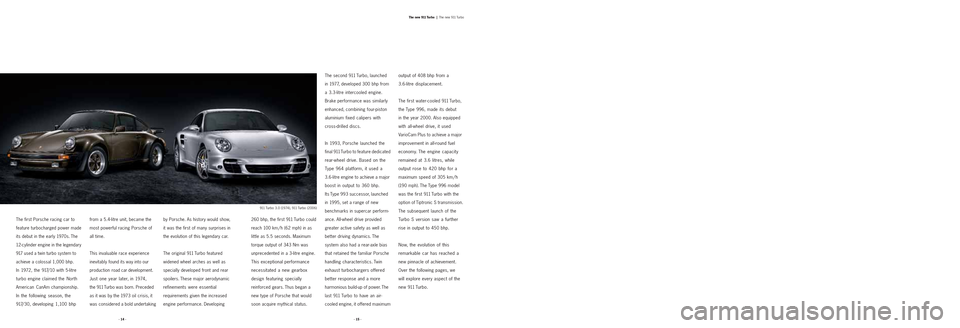
· 14 ·· 15 ·The new 911 Turbo |
The new 911 Turbo
The second 911 Turbo, launched
in 1977, developed 300 bhp from
a 3.3-litre intercooled engine.
Brake performance was similarly
enhanced, combining four-piston
aluminium fixed calipers with
cross-drilled discs.
In 1993, Porsche launched the
final 911Turbo to feature dedicated
rear-wheel drive. Based on the
Type 964 platform, it used a
3.6-litre engine to achieve a major
boost in output to 360 bhp.
Its Type 993 successor, launched
in 1995, set a range of new
benchmarks in supercar perform-
ance. All-wheel drive provided
greater active safety as well as
better driving dynamics. The
system also had a rear-axle bias
that retained the familiar Porsche
handling characteristics. Twin
exhaust turbochargers offered
better response and a more
harmonious build-up of power. The
last 911 Turbo to have an air-
cooled engine, it offered maximum
output of 408 bhp from a
3.6-litre displacement.
The first water-cooled 911 Turbo,
the Type 996, made its debut
in the year 2000. Also equipped
with all-wheel drive, it used
VarioCam Plus to achieve a major
improvement in all-round fuel
economy. The engine capacity
remained at 3.6 litres, while
output rose to 420 bhp fo r a
maximum speed of 305 km / h
(190 mph). The Type 996 model
was the first 911 Turbo with the
option of Tiptronic S transmission.
The subsequent launch of the
Turbo S version saw a further
rise in output to 450 bhp.
Now, the evolution of this
remarkable car has reached a
new pinnacle of achievement.
Over the following pages, we
will explore every aspect of the
new 911 Turbo.The first Porsche racing car to
feature turbocharged power made
its debut in the early 1970s. The
12-cylinder engine in the legendary
917 used a twin turbo system to
achieve a colossal 1,000 bhp
.
In 1972, the 917/10 with 5-litre
turbo engine claimed the North
American CanAm
championship.
In the following season, the
917/30, developing 1,100 bhp
from a 5.4-litre unit, became the
most powerful racing Porsche of
all time.
This invaluable race experience
inevitably found its way into our
production
road car development.
Just one year later, in 1974,
the 911 Turbo was born. Preceded
as it was by the 1973 oil crisis, it
was considered a
bold undertakingby Porsche. As history would show,
it was the first of many surprises in
the evolution of this legendary car.
The original 911 Turbo featured
widened wheel arches as well as
specially developed front and rear
spoilers. These major aerodynamic
refinements were essential
requirements given the increased
engine performance. Developing260 bhp, the first 911 Turbo could
reach 100 km / h (62 mph) in as
little as 5.5 seconds. Maximum
torque output of 343 Nm was
unprecedented in a 3-litre engine.
This exceptional performance
necessitated a new gearbox
design featuring specially
reinforced gears. Thus began a
new type of Porsche that would
soon acquire mythical status.
911 Turbo 3.0 (1974), 911 Turbo (2006)
Page 9 of 61
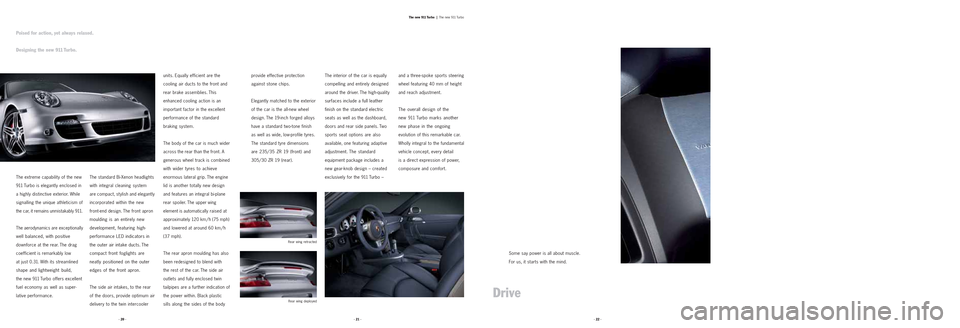
· 22 ·
provide effective protection
against stone chips.
Elegantly matched to the exterior
of the car is the all-new wheel
design. The 19-inch forged alloys
have a standard two-tone finish
as well as wide, low-profile tyres.
The standard tyre dimensions
are 235/35 ZR 19 (front) and
305/30 ZR 19 (rear).
The interior of the car is equally
compelling and entirely designed
around the driver. The high-quality
surfaces include a full leather
finish on the standard electric
seats as well as the dashboard,
doors and rear side panels. Two
sports seat options are also
available, one featuring adaptive
adjustment. The standard
equipment package includes a
new gear-knob design – created
exclusively for the 911 Turbo –
· 21 ·The new 911 Turbo |
The new 911 Turbo
The extreme capability of the new
911 Turbo is elegantly enclosed in
a highly distinctive exterior. While
signalling the unique athleticism of
the car, it remains unmistakably 911.
The aerodynamics are exceptionally
well balanced, with positive
downforce at the rear. The drag
coefficient is remarkably low
at just 0.31. With its streamlined
shape and lightweight build,
the new 911 Turbo offers excellent
fuel economy as well as super-
lative performance.The standard Bi-Xenon headlights
with integral cleaning system
are compact, stylish and elegantly
incorporated within the new
front-end design. The front apron
moulding is an entirely new
development, featuring high-
performance LED indicators in
the outer air intake ducts. The
compact front foglights are
neatly positioned on the outer
edges of the front apron.
The side air intakes, to the rear
of the doors, provide optimum air
delivery to the twin intercoolerunits. Equally efficient are the
cooling air ducts to the front and
rear brake assemblies. This
enhanced cooling action is an
important factor in the excellent
performance of the standard
braking system.
The body of the car is much wider
across the rear than the front. A
generous wheel track is combined
with wider tyres to achieve
enormous lateral grip. The engine
lid is another totally new design
and features an integral bi-plane
rear spoiler. The
upper wing
element is automatically
raised at
approximately 120 km / h (75 mph)
and lowered at around 60 km / h
(37 mph).
The rear apron moulding has also
been redesigned to blend with
the rest of the car. The side air
outlets and fully enclosed twin
tailpipes are a further indication of
the power within. Black plastic
sills along the sides of the body
· 20 ·
Some say power is all about muscle.
For us, it starts with the mind.
Drive
Poised for action, yet always relaxed.
Designing the new 911 Turbo.
Rear wing retracted
Rear wing deployed
and a three-spoke sports steering
wheel featuring 40 mm of height
and reach adjustment.
The overall design of the
new 911 Turbo marks another
new phase in the ongoing
evolution of this remarkable car.
Wholly integral to the fundamental
vehicle concept, every detail
is a direct expression of power,
composure and comfort.
Page 13 of 61
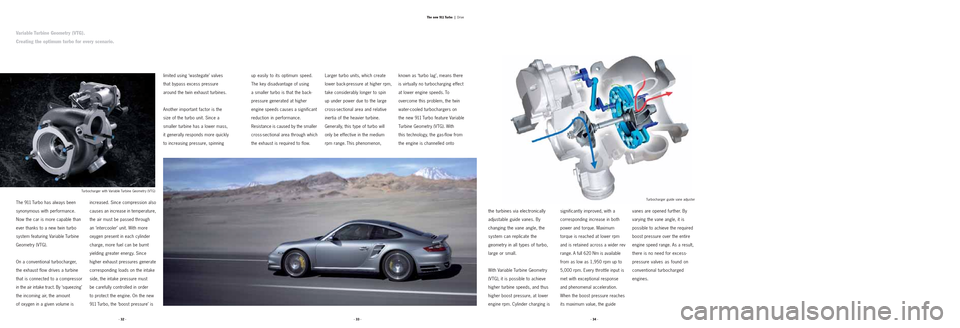
vanes are opened further. By
varying the vane angle, it is
possible to achieve the required
boost pressure over the entire
engine speed range. As a result,
there is no need for excess-
pressure valves as found on
conventional turbocharged
engines.
· 34 · · 32 ·· 33 ·The new 911 Turbo |
Drive
Variable Turbine Geometry (VTG).
Creating the optimum turbo for every scenario.
known as ‘turbo lag’, means there
is virtually no turbocharging effect
at lower engine speeds. To
overcome this problem, the twin
water-cooled turbochargers on
the new 911 Turbo feature Variable
Turbine Geometry (VTG). With
this technology, the gas-flow from
the engine is channelled onto Larger turbo units, which create
lower back-pressure at higher rpm,
take considerably longer to spin
up under power due to the large
cross-sectional area and relative
inertia of the heavier turbine.
Generally, this type of turbo will
only be effective in the medium
rpm range. This phenomenon,
Turbocharger guide vane adjuster Turbocharger with Variable Turbine Geometry (VTG)
up easily to its optimum speed.
The key disadvantage of using
a smaller turbo is that the back-
pressure generated at higher
engine speeds causes a significant
reduction in performance.
Resistance is caused by the smaller
cross-sectional area through which
the exhaust is required to flow.
The 911 Turbo has always been
synonymous with performance.
Now the car is more capable than
ever thanks to a new twin turbo
system featuring Variable Turbine
Geometry (VTG).
On a conventional turbocharger,
the exhaust flow drives a turbine
that is connected to a compressor
in the air intake tract. By ‘squeezing’
the incoming air, the amount
of oxygen in a given volume isincreased. Since compression also
causes an increase in temperature,
the air must be passed through
an ‘intercooler’ unit. With more
oxygen present in each cylinder
charge, more fuel can be burnt
yielding greater energy. Since
higher exhaust pressures generate
corresponding loads on the intake
side, the intake pressure must
be carefully controlled in order
to protect the engine. On the new
911 Turbo, the ‘boost pressure’ islimited using ‘wastegate’ valves
that bypass excess pressure
around the twin exhaust turbines.
Another important factor is the
size of the turbo unit. Since a
smaller turbine has a lower mass,
it generally responds more quickly
to increasing pressure, spinning
the turbines via electronically
adjustable guide vanes. By
changing the vane angle, the
system can replicate the
geometry in all types of turbo,
large or small.
With Variable Turbine Geometry
(VTG), it is possible to achieve
higher turbine speeds, and thus
higher boost pressure, at lower
engine rpm. Cylinder charging issignificantly improved, with a
corresponding increase in both
power and torque. Maximum
torque is reached at lower rpm
and is retained across a wider rev
range. A full 620 Nm is available
from as low as 1,950 rpm up to
5,000 rpm. Every throttle input is
met with exceptional response
and phenomenal acceleration.
When the boost pressure reaches
its maximum value, the guide
Page 14 of 61
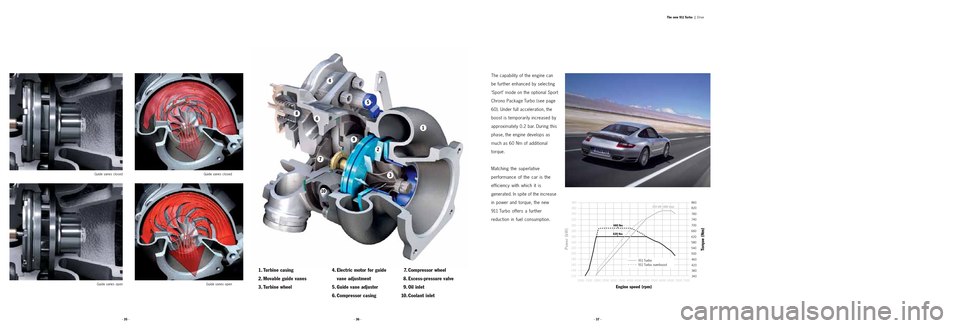
· 36 · · 35 ·· 37 ·The new 911 Turbo |
Drive
Guide vanes open Guide vanes closedGuide vanes open Guide vanes closed
The capability of the engine can
be further enhanced by selecting
‘Sport’ mode on the optional Sport
Chrono Package Turbo (see page
60). Under full acceleration, the
boost is temporarily increased by
approximately 0.2 bar. During this
phase, the engine develops as
much as 60 Nm of additional
torque.
Matching the superlative
performance of the car is the
efficiency with which it is
generated. In spite of the increase
in power and torque, the new
911 Turbo offers a further
reduction in fuel consumption.
1
2
3
4
5
6
7
8
9
10
1. Turbine casing
2. Movable guide vanes
3. Turbine wheel4. Electric motor for guide
vane adjustment
5. Guide vane adjuster
6. Compressor casing7. Compressor wheel
8. Excess-pressure valve
9. Oil inlet
10. Coolant inlet340 500 540
580
620 660 700
220 240
260
280
300
1500
7500 2000 2500 3000 3500 4000 4500 5000 5500 6000 6500 7000
380 420
460
1000
Power (kW)
Engine speed (rpm)
620 Nm
120 140
160
180
200
Torque (Nm)
680 Nm
740 320
340 360380780 820860
353 kW (480 bhp)
911 Turbo
911 Turbo overboost
Page 40 of 61
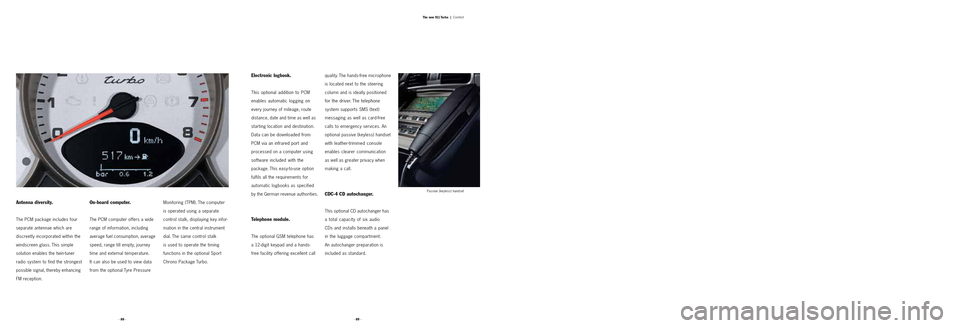
Antenna diversity.
The PCM package includes four
separate antennae which are
discreetly incorporated within the
windscreen glass. This simple
solution enables the twin-tuner
radio system to find the strongest
possible signal, thereby enhancing
FM reception.
On-board computer.
The PCM computer offers a wide
range of information, including
average fuel consumption, average
speed, range till empty, journey
time and external temperature.
It can also be used to view data
from the optional Tyre PressureMonitoring (TPM). The computer
is operated using a separate
control stalk, displaying key infor-
mation in the central instrument
dial. The same control stalk
is used to operate the timing
functions in the optional Sport
Chrono Package Turbo.
Electronic logbook.
This optional addition to PCM
enables automatic logging on
every journey of mileage, route
distance, date and time as well as
starting location and destination.
Data can be downloaded from
PCM via an infrared port and
processed on a computer using
software included with the
package. This easy-to-use option
fulfils all the requirements for
automatic logbooks as specified
by the German revenue authorities.
Telephone module.
The optional GSM telephone has
a 12-digit keypad and a hands-
free facility offering excellent callquality. The hands-free microphone
is located next to the steering
column and is ideally positioned
for the driver. The telephone
system supports SMS (text)
messaging as well as card-free
calls to emergency services. An
optional passive (keyless) handset
with leather-trimmed console
enables clearer communication
as well as greater privacy when
making a call.
CDC-4 CD autochanger.
This optional CD autochanger has
a total capacity of six audio
CDs and installs beneath a panel
in the luggage compartment.
An autochanger preparation is
included as standard.
· 88 ·· 89 ·The new 911 Turbo |
Comfort
Passive (keyless) handset
Page 44 of 61
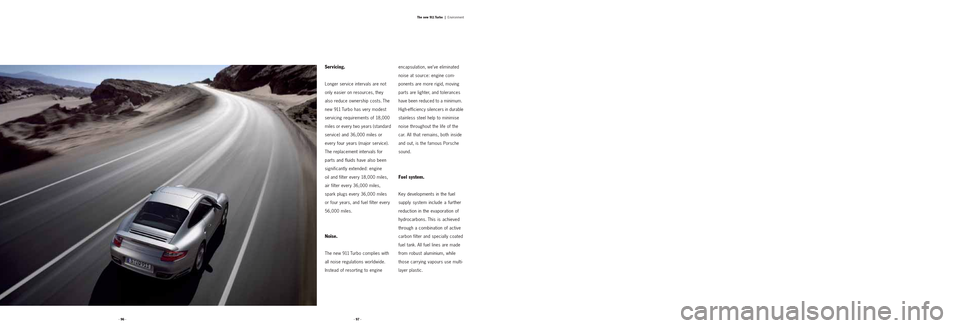
Servicing.
Longer service intervals are not
only easier on resources, they
also reduce ownership costs. The
new 911 Turbo has very modest
servicing requirements of 18,000
miles or every two years (standard
service) and 36,000 miles or
every four years (major service).
The replacement intervals for
parts and fluids have also been
significantly extended: engine
oil and filter every 18,000 miles,
air filter every 36,000 miles,
spark plugs every 36,000 miles
or four years, and fuel filter every
56,000 miles.
Noise.
The new 911 Turbo complies with
all noise regulations worldwide.
Instead of resorting to engineencapsulation, we’ve eliminated
noise at source: engine com-
ponents are more rigid, moving
parts are lighter, and tolerances
have been reduced to a minimum.
High-efficiency silencers in durable
stainless steel help to minimise
noise throughout the life of the
car. All that remains, both inside
and out, is the famous Porsche
sound.
Fuel system.
Key developments in the fuel
supply system include a further
reduction in the evaporation of
hydrocarbons. This is achieved
through a combination of active
carbon filter and specially coated
fuel tank. All fuel lines are made
from robust aluminium, while
those carrying vapours use multi-
layer plastic.
· 96 ·· 97 ·The new 911 Turbo |
Environment
Page 58 of 61
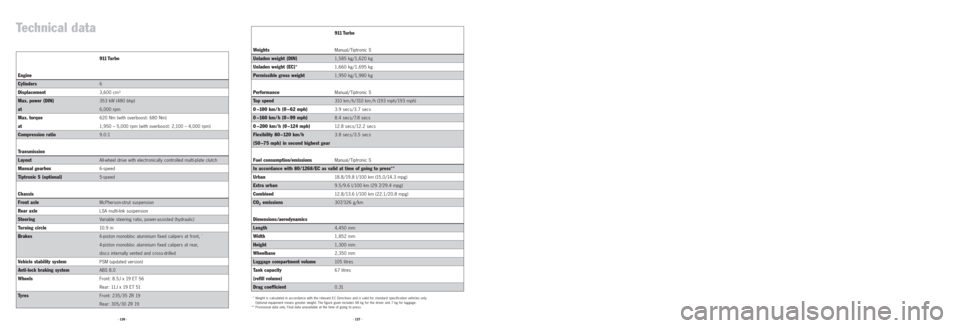
· 126 ·· 127 ·
Technical data911 Turbo
WeightsManual/ Tiptronic S
Unladen weight (DIN)1,585 kg/1,620 kg
Unladen weight (EC)*1,660 kg/1,695 kg
Permissible gross weight1,950 kg/1,980 kg
PerformanceManual/ Tiptronic S
Top speed310 km / h/310 km / h (193 mph/193 mph)
0 –100 km / h (0 – 62 mph)3.9 secs/3.7 secs
0 –160 km / h (0 – 99 mph)8.4 secs/7.8 secs
0 – 200 km / h (0 –124 mph)12.8 secs/12.2 secs
Flexibility 80 –120 km / h 3.8 secs/3.5 secs
(50 –75 mph) in second highest gear
Fuel consumption/emissionsManual/ Tiptronic S
In accordance with 80 / 1268 /EC as valid at time of going to press**
Urban18.8/19.8 l/100 km (15.0/14.3 mpg)
Extra urban9.5/9.6 l/100 km (29.7/29.4 mpg)
Combined12.8/13.6 l/100 km (22.1/20.8 mpg)
CO2emissions307/326 g/km
Dimensions /aerodynamics
Length4,450 mm
Width1,852 mm
Height1,300 mm
Wheelbase2,350 mm
Luggage compartment volume105 litres
Tank capacity 67 litres
(refill volume)
Drag coefficient
0.31
911 Turbo
Engine
Cylinders6
Displacement3,600 cm3
Max. power (DIN)353 kW (480 bhp)
at6,000 rpm
Max. torque620 Nm (with overboost: 680 Nm)
at1,950 – 5,000 rpm (with overboost: 2,100 – 4,000 rpm)
Compression ratio9.0 :1
Transmission
LayoutAll-wheel drive with electronically controlled multi-plate clutch
Manual gearbox6-speed
Tiptronic S (optional)5-speed
Chassis
Front axleMcPherson-strut suspension
Rear axleLSA multi-link suspension
SteeringVariable steering ratio, power-assisted (hydraulic)
Turning circle10.9 m
Brakes6-piston monobloc aluminium fixed calipers at front, `
4-piston monobloc aluminium fixed calipers at rear,
discs internally vented and cross-drilled
Vehicle stability systemPSM (updated version)
Anti-lock braking systemABS 8.0
WheelsFront: 8.5J x 19 ET 56
Rear: 11J x 19 ET 51
Ty r e sFront: 235/35 ZR 19
Rear: 305/30 ZR 19* Weight is calculated in accordance with the relevant EC Directives and is valid for standard specification vehicles only.
Optional equipment means greater weight. The figure given includes 68 kg for the driver and 7 kg for luggage.
** Provisional data only. Final data unavailable at the time of going to press.